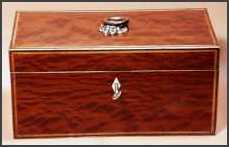 |
Partridge wood is so called because the grain
pattern resembles the plumage of a partridge. It
was a rare exotic wood imported from Tropical
America in the late 18th century and only used in
the finest work. The top of the caddy has a
centrally placed gilded brass carrying handle.
The gilding is hardly worn. The pattern of the
handle is in stylised foliage and the loop
continues this motive. |
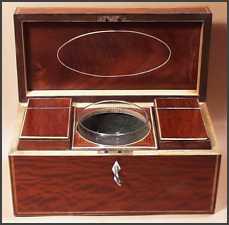 |
The caddy is in very good original condition
and has a working lock with key. It
has not been refinished. The
inside of the lid is lined with flame figured
mahogany with an oval of boxwood inlaid in the
Sheraton manner.
The central compartment has the original heavy
hand blown crystal mixing bowl (see below). The
bowl sits in a specially made recess, which is
faced with mitered and book matched partridgewood
banded with boxwood. The well is still lined with
the original green baize, which shows the sort of
wear one would expect.
|
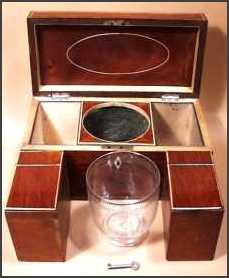 |
The facings on the top are in dark wood
whereas the facings of the body are in maple.
This use of contrasting woods is a feature in
good early boxes; it avoids the opening being
over visible when the caddy is closed and adds
interest when open. The central compartment is
flanked by two lift out mahogany tea canisters
with hinged partridgewood lids. These are edged
in boxwood. The grain pattern on these is the
same as the outside of the caddy but smaller,
which is more suitable for the size of the
canisters. This is yet another example of the
care and flair of the craftsman who made this
fine caddy
|
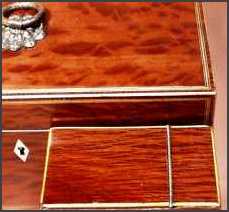 |
The grain pattern of the canisters is the
same as the outside of the caddy but the flecks
are smaller, and more suitable for the size of
the canisters. This is yet another example of
the care and flair of the craftsman who made this
fine caddy
The canisters are edged with boxwood.
|
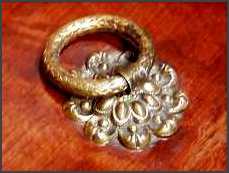 |
The top of the caddy has a centrally placed
gilded brass carrying handle. The gilding is
hardly worn. The pattern of the handle is in
stylised foliage and the loop continues this
motive. This is the original embossed handle made
by impression and not a modern cast brass copy
used as a replacement |
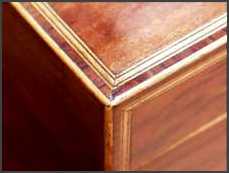 |
Detail of corner showing the exotic
partridgewood edged with fine lines of boxwood
and ebony and a cross banding of kingwood.
Partridge wood is so called because the grain
pattern resembles the plumage of a partridge. It
was a rare exotic wood imported from tropical
America in the late 18th century and
only used in the finest work. |
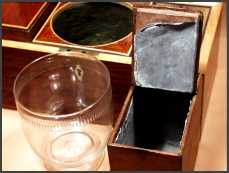 |
The central compartment has a blown crystal
mixing bowl with pontil mark, which has been
enhanced with fine wheel engraving. The bowl sits
in a specially made recess, which is faced with
mitered and book matched partridgewood. The well
is still lined with the original green baize. The
lead lining of the canisters is nearly intact.
This was probably replaced in the mid 19th
century. The original wood with remnants of the
18th C lead is visible underneath. A lead liner
was used to maintain the moisture or humidity in
the tea.
|
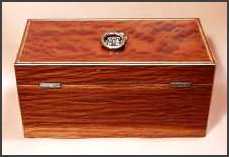 |
The back and sides of the caddy has the same
beautifully figured partridgewood. The area
nearest the bottom on the back is a lighter
colour than the rest, as can be seen in this
picture. |
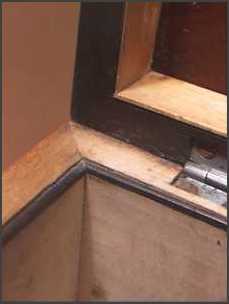 |
In this detail photograph of a inside corner
of the body of the caddy the quality of the work
is clearly visible. The facings on the top are in
dark ebony whereas the facings of the body are in
maple. This is a feature in good early boxes.
It adds interest when the caddy is open and
elegantly avoids the opening being over visible
when the caddy is closed
The well for the canister is lined with maple
edged with ebony which has been rounded to a
bead.
|
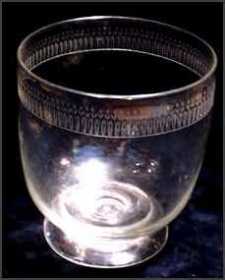 |
The bowl like the caddy is in the typical
George III classical form. This is enhanced with
subtle and exquisite wheel engraving. This
bowl is the original heavy hand blown crystal
mixing bowl with pontil mark.
A pontil mark is the slight scar on the bottom
of the bowl left after detaching it from the
pontil. The pontil is an iron rod used in
glass-making. The presence of the pontil mark
shows that it is hand blown glass. Some people
call it a punty mark.
|
